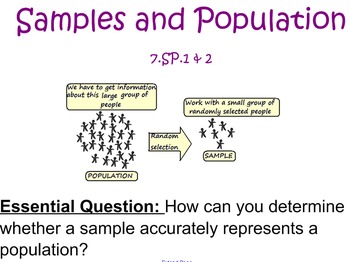Samples and Population
Kelsey Haggard
18 Followers
Grade Levels
6th - 8th
Subjects
Resource Type
Standards
CCSS7.SP.A.1
CCSS7.SP.A.2
Formats Included
- NOTEBOOK (SMARTboard) File
Kelsey Haggard
18 Followers
Description
Notes and practice problems to tell the difference of samples and population, biased and unbiased and if data collected is valid.
Total Pages
Answer Key
N/A
Teaching Duration
N/A
Report this resource to TPT
Reported resources will be reviewed by our team. Report this resource to let us know if this resource violates TPT’s content guidelines.
Standards
to see state-specific standards (only available in the US).
CCSS7.SP.A.1
Understand that statistics can be used to gain information about a population by examining a sample of the population; generalizations about a population from a sample are valid only if the sample is representative of that population. Understand that random sampling tends to produce representative samples and support valid inferences.
CCSS7.SP.A.2
Use data from a random sample to draw inferences about a population with an unknown characteristic of interest. Generate multiple samples (or simulated samples) of the same size to gauge the variation in estimates or predictions. For example, estimate the mean word length in a book by randomly sampling words from the book; predict the winner of a school election based on randomly sampled survey data. Gauge how far off the estimate or prediction might be.





